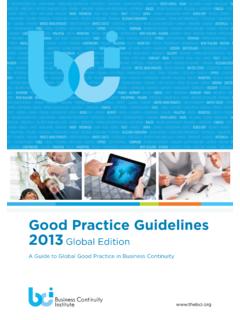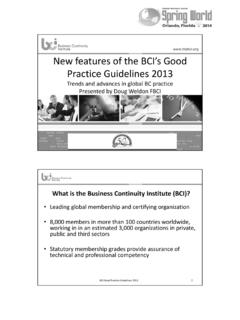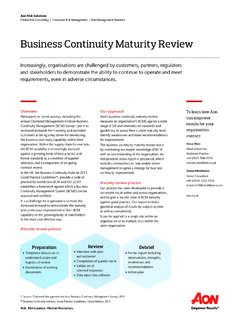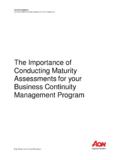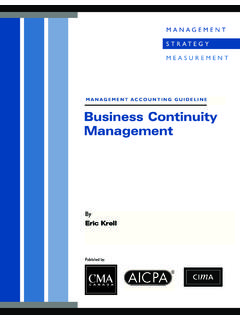Transcription of Business Continuity and Crisis Management - DMISA
1 Licensed institute of Business Continuity Management NPC 2012 . All Rights Reserved Page 1 of 31 Reg. No. 2012/004736/08 Organisation Resilience: Business Continuity , Incident and Corporate Crisis Management . Introduction Despite their best endeavours no organisation can have complete control over its Business environment especially its supply chain. It is therefore essential for both public and private sector organisations to have an effective and appropriate Business Continuity Management (BCM), incident and corporate Crisis Management capability. This paper is by Dr David J.
2 Smith MBA (Hons) FIBCM BCCE who is the Chairperson of the institute of Business Continuity Management . He is also a practicing Business Continuity professional and Director of several companies that provide Business Continuity consultancy and training. David is also the Business Continuity lead, author and principle trainer of the accredited BCM Diploma at the Hatfield Tuition College of the HTC Further Education Training Colleges in Pretoria, Johannesburg and Cape Town. The paper outlines various considerations, issues and approaches that can help organisations prepare for Business Continuity , incident and corporate Crisis Management within the context of the BCM life cycle (see Figure 3) and are aligned to BS25999 and ISO22301.
3 In particular the paper addresses the following issues within the context of Business Continuity : Business Continuity Management (BCM); Corporate Governance and other key drivers; BCM standards; A BCM System (BCMS); Building and embedding BCM within the organisation; Avoiding the planning bureaucracy Using accepted standards; The BCMS framework and workflow: Incident and Corporate Crisis Management ; A three tier response and governance structure; Categories of incident and corporate Crisis ; Incident and corporate Crisis Management implementation programme; Review and evaluating performance; Summary; The fatal price of failure; Suggested further reading and references So what is the difference between what is already in place and why is it so important?
4 Both national and international events of recent years has led Governments, regulators, insurers and other public and private sector bodies to emphasise and actively promote the view that a robust, proactive, effective and appropriate level of organisation resilience and proven BCM preparedness is essential. As part of the overall risk Management of an organisation and in the face of the challenges and threats that inevitably arise in today s national and global Business and public sector service environment complacency is wholly unacceptable. Licensed institute of Business Continuity Management NPC 2012.
5 All Rights Reserved Page 2 of 31 Reg. No. 2012/004736/08 This warning is reinforced by historical research and the issues are further highlighted and reinforced in the findings and conclusions of recently published research conducted by the institute of Risk Management (UK).1 The summary of the conclusions of that research are that .. Many of the risks we have highlighted are inherent in every organisation. Unrecognised and unmanaged, these underlying risks pose a potentially lethal threat to the future of even the largest and most successful businesses. Boards, particularly chairmen and NEDs (non-executive directors), have a large, important blind spot in this dangerous area.
6 Without board leadership, these risks will remain hidden because only boards can ensure that enough light shines on these hard to see risks .2 In respect of the research and its findings Mark Taylorson considers, The case studies outlined in Roads to Ruin consist of some of the world s biggest organisations, with the risk events having considerable, often catastrophic, impacts on these organisations. In seven cases the companies faced bankruptcy. In eleven cases the Chairman and/or CEO lost their roles and a huge number of executive and non-executive directors lost their it identifies key flaws within these organisations risk Management that significantly contributed to these Directors have to make crucial risk-related decisions impacting the future of their companies and Roads to Ruin provides them with important lessons in the flow of information, communication and corporate governance that were found lacking in the case studies investigated.
7 3 Whilst many commentators within the public sector describe the differences between the public and private sector I firmly believe the Management discipline of BCM, incident and corporate Crisis Management is common to both. This is reinforced by King III and its associated guidelines. However, in recognising the differences in the raison d etre of both the public and private sectors it is perhaps helpful to consider BCM as Service Continuity Management in respect of the public sector. Within this context it is recognised that both sectors are producing either a service or product for consumption by an internal or external customer or client and have various stakeholders.
8 As a consequence, reference to Business ..is intended to be interpreted broadly to mean those activities that are core to the purposes of an organisation s existence .4 Business Continuity Management (BCM) Business Continuity Management (BCM) is defined by the British Standards institute (BSI) as an holistic Management process that identifies potential threats to an organization and the impacts to Business operations that those threats, if realized, might cause, and which provides a framework for building organizational resilience with the capability for an effective response that safeguards the interests of its key stakeholders, reputation, brand and value creating activities.
9 5 The term Business Continuity Management is used rather than Business Continuity planning . This approach is deliberate because planning implies there is a start and end to the process and can lead to unwanted planning bureaucracy. Within this context Business Continuity planning is still a critical and key component of a BCM programme. In contrast to the earlier narrow and reactive approaches to BCM it is now recognised as a dynamic, proactive, and ongoing Business as usual Management process. To be effective it must be complete against a standard, appropriate (fit for purpose), practical, realistic, up-to-date, effective and a plausible (proven) capability.
10 At a time when Just In Time (JIT) delivery, procurement and supply chain issues in general have a high profile there is a need to consider the big picture and both the fragility and resilience of an organisation s capability to deliver its own products and services. In particular the organisation s supply chain and their dependency upon it. In addition there are regulatory, legal, insurance, licence and contractual requirements to consider whereby contract Management takes on a different role to that traditionally recognised. Within this context there is the 1 AIRMIC (2011) Roads to Ruin - A Study of Major Risk Events; their origins, impacts and implications 2 AIRMIC (2011) Roads to Ruin 3 Mark Taylorson, 2011.
